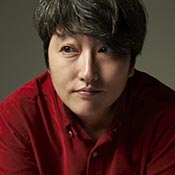16th(2014)
Habitual Sadness
BYUN Youngjoo
- Korea
- 1997
- 56min
- DV,DD
- color
- Documentary
SYNOPSIS
Synopsis
By examining the everyday life of former ‘comfort women’, this film illustrates the change in their relationship with the society. Through their effort to overcome the society’s prejudice and physical pain, the elderly victims actively lead their lives and transform their relationship with the world. In doing so, they find a new meaning in life. As we realize that the elderly victims are indeed the most dignified and confident women, we come to cherish the will to turn habitual sadness into hope for life.
Program Note
Through The Murmuring, the history Korean society has sealed made an abrupt appearance to this world. The Murmuring shows
the change of relationship between the director and old women as time passes and becomes a platform the old women step on to
come out to the world after decades of suppression.
The old women, once the subjects in front of the camera, are transformed into active participants who reveal their faces and the
history to the world. Watching themselves so close, the women, the victims in the past, demanded the director to film their voices.
This was the dynamic force that kept The Murmuring running.
Habitual Sadness begins at the funeral. A girl in primary school was forced to work at an armaments factory and later became
a comfort woman. Since then, she held her breath to survive and in 1992, she finally let the world know the violence she went
through and initiated the movement to receive an apology and compensation from the Japanese government. Her name is KANG
Duk-Gyeong and she was diagnosed with late-stage lung cancer in the winter of 1995.
KANG asked the director to record her life until her death because she was afraid of being forgotten. This touched the director and
made her produce Habitual Sadness which constantly throws questions and answers about our history covering from the World
War II era up until 1997, when Korea’s sexual assault incidence rate was ranked first in the world. KANG’s paintings, containing pain
and sorrow, graphically remind us of the unfinished assignment we need to remember and solve, including the condolences for
KANG who was reduced to ashes. [LEE Angela]
PROGRAM NOTE
Synopsis
By examining the everyday life of former ‘comfort women’, this film illustrates the change in their relationship with the society. Through their effort to overcome the society’s prejudice and physical pain, the elderly victims actively lead their lives and transform their relationship with the world. In doing so, they find a new meaning in life. As we realize that the elderly victims are indeed the most dignified and confident women, we come to cherish the will to turn habitual sadness into hope for life.
Program Note
Through The Murmuring, the history Korean society has sealed made an abrupt appearance to this world. The Murmuring shows
the change of relationship between the director and old women as time passes and becomes a platform the old women step on to
come out to the world after decades of suppression.
The old women, once the subjects in front of the camera, are transformed into active participants who reveal their faces and the
history to the world. Watching themselves so close, the women, the victims in the past, demanded the director to film their voices.
This was the dynamic force that kept The Murmuring running.
Habitual Sadness begins at the funeral. A girl in primary school was forced to work at an armaments factory and later became
a comfort woman. Since then, she held her breath to survive and in 1992, she finally let the world know the violence she went
through and initiated the movement to receive an apology and compensation from the Japanese government. Her name is KANG
Duk-Gyeong and she was diagnosed with late-stage lung cancer in the winter of 1995.
KANG asked the director to record her life until her death because she was afraid of being forgotten. This touched the director and
made her produce Habitual Sadness which constantly throws questions and answers about our history covering from the World
War II era up until 1997, when Korea’s sexual assault incidence rate was ranked first in the world. KANG’s paintings, containing pain
and sorrow, graphically remind us of the unfinished assignment we need to remember and solve, including the condolences for
KANG who was reduced to ashes. [LEE Angela]
Director
-

BYUN YoungjooBYUN Youngjoo
Since she made Korean first theatrical documentary The Murmuring (1995), BYUN went on to complete a documentary trilogy on the victims of Japanese military 'Comfort Women'. Deep Loves (2002) was her first feature film and Helpless (2012) was awarded the Best Director Award at the Baeksang Arts Awards in 2012. Currently, she is working on a film based on KANG Full’s Webtoon Lamp Shop.

